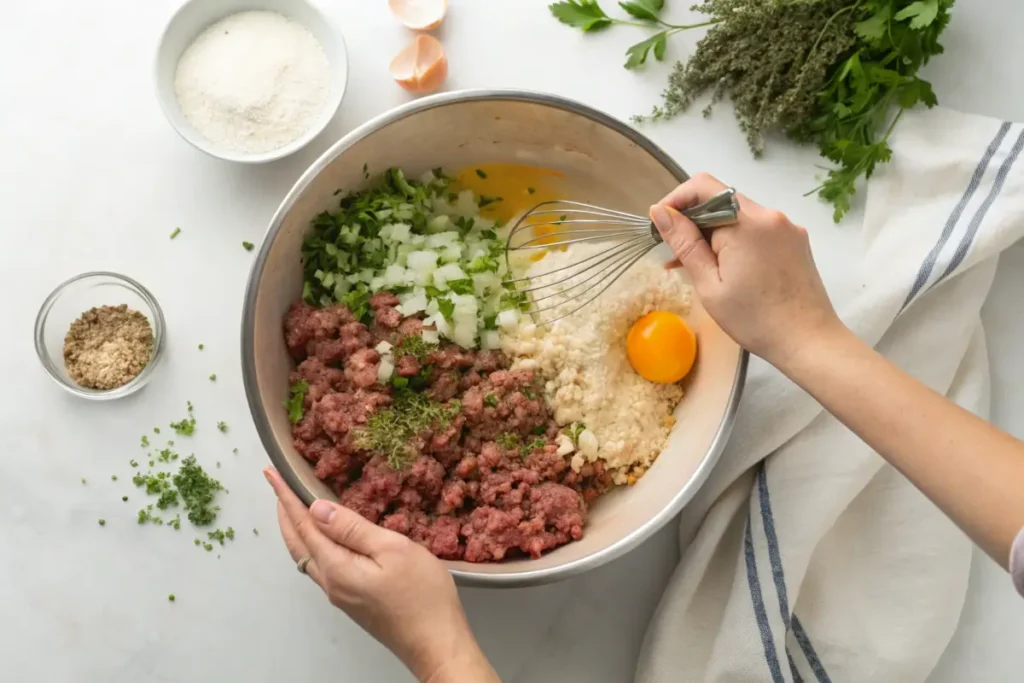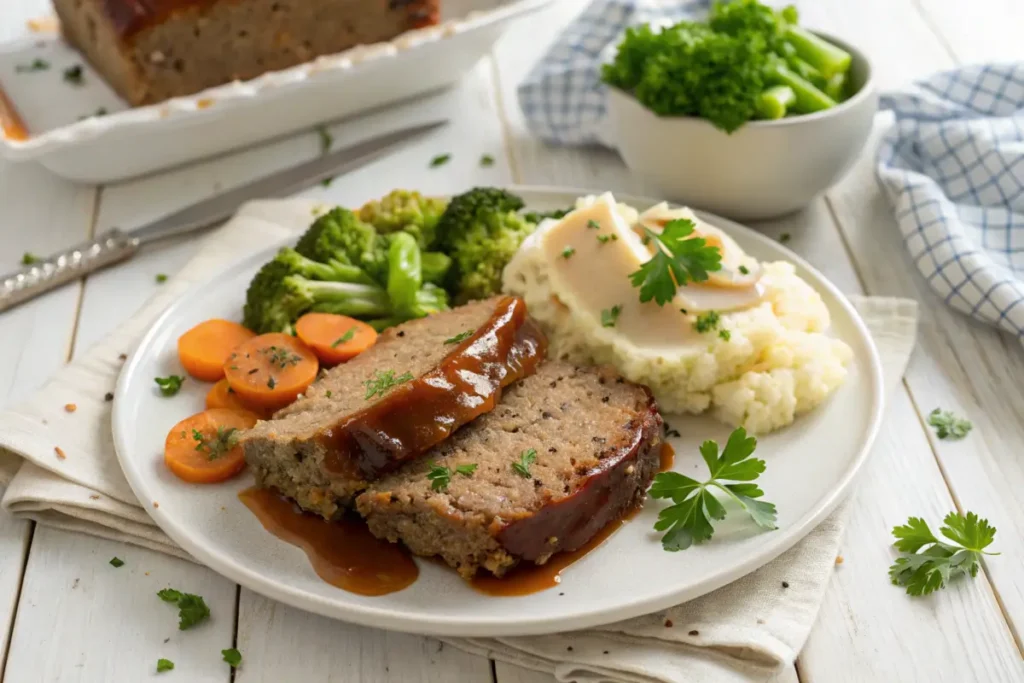Meatloaf is one of those hearty comfort foods that make you feel right at home. In this article, we’re delving into what is the basic meatloaf formula? and how to master it so your dinners come out juicy yet firm every single time.
With easy-to-follow tips on everything from common binders to oven temperatures, you’ll uncover the key protein-to-binder ratio along with inventive twists to keep your recipe fresh. Ready to learn the ropes? Let’s dig in!
Understanding “What Is the Basic Meatloaf Formula?”
Defining the Concept Behind a Basic Meatloaf Recipe Formula
Most folks see meatloaf as simply ground meat tossed together with breadcrumbs and tossed into the oven until done. Yet the classic meatloaf recipe rests on a special ratio of ground meat, binder, and liquid. In fact, this core structure answers that popular question: What is the basic meatloaf formula? By balancing these elements, you’re guaranteed a loaf that stays moist on the inside and has just the right texture.
Traditionally, people use a combo of beef, pork, or turkey paired with breadcrumbs or oats. Such choices help the loaf hold its shape without crumbling apart. Meanwhile, liquid ingredients—like milk or broth—ensure your mixture doesn’t turn dry or rubbery. The perfect ground meat mixture ratio often hovers around one pound of protein to one cup of binder and roughly half a cup of liquid.
Why the Right Meatloaf Ratio of Protein, Binder, and Liquid Matters
Getting the ratio right impacts taste and tenderness. Too little binder, and your loaf collapses. Too much liquid, and it ends up soggy. Striking that sweet spot keeps every slice amazingly tender. This simple meatloaf instruction helps you avoid common pitfalls while nailing a comfort food dinner that pleases the whole family. Understanding these elements in depth sets the foundation for all the parts that follow in this trusty recipe journey.
Essential Ingredients in a Simple Meatloaf Dish
Choosing the Right Ground Meat (Beef, Pork, Turkey) for Your Family Meatloaf Recipe
When it comes to building a classic meatloaf recipe, the right ground meat can make or break the dish. First, decide if you want to use beef, pork, turkey, or a combination. Many home cooks choose beef because it delivers that rich flavor typical of a traditional meatloaf dish. However, using pork or turkey, or even mixing different types, can keep your loaf moist and give it a delightful twist. Furthermore, leaner meats may need added moisture—like a small splash of broth—to prevent dryness and help you achieve those moist meatloaf tips.
Common Binders (Breadcrumbs, Oats, Crackers) and Their Roles in a Basic Meatloaf Recipe Formula
Most people who ask, “What is the basic meatloaf formula?” soon learn that binders help hold your ground meat mixture together. Breadcrumbs, oats, and crushed crackers all serve as smart choices. Moreover, these easy ingredients soak up excess liquid, preventing a soggy texture.
In addition, they contribute to that satisfying chew we all love in a hearty ground beef meal. If you’re seeking juicy meatloaf secrets, consider adding grated onions or carrots—these veggies release juices during baking, ensuring extra moisture.Most recipes include eggs for firmness. Additionally, a small amount of meatloaf glaze or sauce, whether ketchup-based or a tangy barbecue blend, elevates the overall flavor.
Remember, adding seasoning blends such as onion powder, garlic powder, and fresh herbs can transform your loaf from bland to spectacular in no time. By mixing the right protein with optimal binders and a touch of liquid, you set yourself up for success and ensure a family favorite dinner every time.
Ratios That Explain What Is the Basic Meatloaf Formula?
Meatloaf Ratio Breakdown: Protein-to-Binder-to-Liquid Proportions
At the heart of what is the basic meatloaf formula? lies the golden ratio of protein, binder, and liquid. Typically, one pound of ground meat needs about one cup of binder and a half-cup of liquid. Moreover, the protein-to-binder ratio ensures your loaf won’t crumble or turn mealy, and it strengthens the structure so each slice remains intact. For instance, if you’re whipping up a homemade meatloaf recipe with turkey, you might add a touch more liquid since it contains less fat. On the other hand, a beef-and-pork combo often boasts enough richness to keep things moist.
Balancing Seasonings, Herbs, and Vegetables in a Simple Meatloaf Dish
In addition to the main ratio, seasonings play a massive role. Rather than relying on salt and pepper alone, toss in fresh parsley, grated onion, or a dash of Worcestershire sauce to create a quick and easy meatloaf brimming with personality. Furthermore, you can slip in finely diced carrots, celery, or spinach for added nutrition. This strategy lends extra moisture and variety to your loaf’s flavor profile.
However, do keep an eye on total liquid content since watery vegetables can tip the balance if you’re not careful.Striving for a traditional meatloaf dish? Consider parsley and thyme. Craving a southwestern spin? Sprinkle in chili powder or cumin. No matter the direction, these simple meatloaf instructions follow the same ratio principle, helping your loaf stay uniform yet flavorful. Additionally, remember to combine ingredients gently—mashing them harshly can toughen the texture.
With the right ratio of meat, binder, and liquid, plus creative spice choices, you’ll achieve that perfect balance between firm slices and a tender bite. Ultimately, this ratio unlocks the key to a family favorite dinner and answers the timeless question: “What is the basic meatloaf formula?”
Step-by-Step Guide to Crafting a Family Meatloaf Recipe

Preparing the Mixture for a Basic Meatloaf Recipe Formula
First, gather all your ingredients in one place. You’ll need your chosen ground meat mixture—be it beef, pork, or turkey—plus your favorite binder, such as breadcrumbs or crushed crackers. Additionally, don’t forget a light liquid, like milk or broth, to keep things moist.
Begin by blending the ground meat and simple meatloaf instructions seasonings: a sprinkle of salt, pepper, and onion powder. Then, gently fold in the binder and eggs. Consequently, this step ensures the loaf holds together without turning rubbery. Some cooks like to add grated vegetables—such as carrots or onions—for extra flavor. Others rely on classic spices like thyme to build a more traditional meatloaf dish.After mixing, pause and check the texture. If it seems dense, add a splash more liquid. If it feels too soft, toss in an extra handful of breadcrumbs.
This fine-tuning helps you reach that perfect protein-to-binder ratio. When the consistency looks right, avoid overmixing. Rather than mashing brutally, gently press the ingredients together so you maintain that juicy meatloaf secret.
The Ideal Shape and Baking Method: What Is the Basic Meatloaf Formula?
Next, shape your loaf on a baking sheet or in a lightly greased loaf pan. In many classic meatloaf recipes, a rectangular form is popular, yet you could opt for a free-form shape if desired. Make sure it’s uniformly thick for even cooking. Then, for that final flourish, spread a meatloaf glaze or sauce on top.
This glaze often blends ketchup, brown sugar, and mustard. Ultimately, a carefully formed loaf shows off what is the basic meatloaf formula in action. By sticking to the right ratio and shaping method, you ensure a hearty ground beef meal that slices beautifully and remains tender inside.
Cooking Techniques and Time Management
Oven Temperatures and Cooking Times for Moist Meatloaf
Getting your loaf into the oven at the right heat can turn a quick and easy meatloaf into a savory masterpiece. Many home cooks place the loaf in a preheated 350°F (175°C) oven, which gently bakes the blend without drying it out. However, you could raise the temperature to shorten cooking time, though you risk losing that moist texture. On average, a standard two-pound loaf takes 50 to 60 minutes at 350°F, yet oven variations matter.
Hence, always track internal temperature to avoid overcooking.Some prefer placing the loaf on a roasting rack, allowing excess fat to drip away. Meanwhile, others bake it directly in a loaf pan for a dense, family favorite dinner. If you choose a lean protein like turkey, it’s wise to include extra binder or liquid. Otherwise, the edges might become tough. Further, covering the loaf with foil for the first half of the baking process can help lock in moisture. Then, removing the foil later allows the glaze to caramelize.
How to Check for Doneness Without Drying It Out
Above all, aim for an internal temperature of 160°F (71°C) for ground beef or pork, and 165°F (74°C) for turkey. Slide a meat thermometer into the thickest part of the loaf. If it’s still under temp, pop it back in the oven. Also, try not to cut into your loaf right away. Let it rest for about 10 minutes so the juices redistribute.
Indeed, nothing ruins meatloaf texture and flavor faster than slicing it immediately and watching all the moisture escape!Keep these tips in mind, and your homemade meatloaf recipe will remain succulent. Whether you’re following traditional meatloaf dish guidelines or spicing things up with herbs and vegetables, timed baking and proper checks are the keys to success.
Over time, this practice becomes second nature. Then, when someone asks, “What is the basic meatloaf formula?” you’ll be ready with all the right answers.
Creative Variations on the Basic Meatloaf Formula
Meatloaf with International Flavors (Italian, Mexican, BBQ)
Sometimes, the question “What is the basic meatloaf formula?” leads us to experiment beyond classic beef. For instance, you can infuse Italian flare into your simple meatloaf instructions by adding oregano, basil, and a layer of mozzarella cheese. Meanwhile, a Mexican-inspired version could include chopped jalapeños, cumin, and even a sprinkle of taco seasoning. Top it with a salsa glaze for extra zest.
Additionally, barbecue lovers can swap out the usual ketchup for a tangy BBQ sauce, tossing in smoked paprika or chipotle powder to boost the smoky punch.When you switch flavor profiles, remember to keep the same protein-to-binder ratio. In other words, staying within that balance helps ensure your classic meatloaf recipe remains moist and delicious, regardless of the seasonings you use. Likewise, tucking in bits of cheddar or roasted veggies can enhance texture without compromising the basic beef loaf recipe foundation. Ultimately, these international twists let you travel the world from your dinner table.
Health-Conscious Tweaks (Lean Meats, Gluten-Free Options)
For a lighter approach, turn to turkey or chicken as your ground meat mixture. But be sure to add extra moisture, like mushrooms or a low-sodium broth, to maintain that succulent bite. If gluten-free is your priority, lean on oats or gluten-free breadcrumbs. Another tactic involves boosting nutrition with chopped greens such as spinach or kale. Above all, these health-conscious tweaks prove that you can still enjoy a hearty ground beef meal—even if you skip the beef altogether—while adhering to what is the basic meatloaf formula?
Serving Suggestions and Side Dishes

Comfort Food Pairings (Mashed Potatoes, Roasted Veggies)
When folks envision a comfort food dinner, meatloaf often stars as the main dish. Pairing it with creamy mashed potatoes turns any meal into a special occasion. In fact, that buttery potato goodness balances the savory flavors of a traditional meatloaf dish. If you want to add color, roasted veggies—like carrots, zucchini, or Brussels sprouts—make wonderful companions. Moreover, a simple green salad topped with a zesty vinaigrette can lighten the plate if you’re aiming for a balanced approach.
Garnishes and Sauces That Complement Meatloaf
Although many stick to the classic ketchup-based flavor, you can enhance your loaf with signature sauces. For instance, a rich mushroom gravy adds depth to your homemade meatloaf recipe. Another option might be a sweet-tangy onion jam to counter the richness. Additionally, if you’re going for a barbecue style, consider drizzling more sauce just before serving for a glossy finish.
In any case, these garnishes and sides help highlight what is the basic meatloaf formula? by enhancing texture and taste. Furthermore, leftover slices often reheat remarkably well, so go ahead and schedule that family favorite dinner or pack a quick lunch the next day. Your table guests will be more than grateful for these finishing touches!
FAQs
How Do I Keep Meatloaf Moist?
In many households, dryness is a common meatloaf complaint. However, moisture issues often relate to the right protein-to-binder ratio. Incorporate grated or sautéed veggies, such as onions or zucchini, to introduce natural juiciness. Additionally, ensure you add enough liquid, like broth or milk. Nonetheless, remember that overbaking will quickly zap out that much-needed moisture, so keep an eye on the internal temperature.
Is It Better to Cover My Meatloaf While Baking?
Covering your loaf for at least part of the baking time can help seal in steam and boost moisture. Yet, you might remove the cover near the end to brown the top or glaze. This strategy especially helps if you’re using lean meats that overcook easily. Consequently, you’ll find your slices remain tender, matching what is the basic meatloaf formula? guidelines.
How Many Eggs Should I Use for Binder?
Typically, one or two eggs suffice for every pound or so of ground meat. The eggs help the loaf hold its shape by binding the mixture together. Plus, they deliver a richer taste. But do not rely solely on eggs; combine them with breadcrumbs or oats to prevent a dense bite.
Why Does My Meatloaf Fall Apart?
A crumbling loaf usually points to unbalanced elements. Perhaps you skimped on binder, or you formed the mixture too tightly. Be sure to handle it gently, and add enough moist ingredients. Furthermore, following the classic meatloaf recipe ratio keeps the texture just right so your loaf slices neatly and remains scrumptious.
Conclusion: Mastering the Basic Meatloaf Formula
Recap of Key Ratios and Techniques
When people ask, “What is the basic meatloaf formula?” the answer lies in uniting protein, binder, and liquid in harmony. With roughly one pound of ground meat, one cup of breadcrumbs, and half a cup of liquid, you build a sturdy yet soft loaf. Knowing how to season and bake at the right temperature also impacts the final flavor.
Encouragement to Experiment and Perfect Your Own Version
Although the core formula stands, feel free to tinker with spices, glazes, and vegetables. Maybe try barbecue sauce in place of ketchup, or add fresh herbs for a unique spin. Through small changes, you’ll soon discover new tastes—yet remain true to that classic meatloaf recipe foundation. Above all, keep balancing ingredients until you strike the perfect combo. That way, you’ll enjoy a moist, flavorful dish that proves you’ve truly mastered what is the basic meatloaf formula?
- Complete Marry Me Chickpeas Guide
- Clearly indicates a full resource on preparing Marry Me Chickpeas, aligning with the page’s focus.
- Marry Me Chickpeas Recipe for a Romantic Meal
- Describes both the dish and the meal’s theme, avoiding generic language like “click here”
- In-Depth Look at Marry Me Chickpeas
- Tells readers they’ll get a comprehensive overview of this popular recipe.
- Low-Fat Vegan Meals Inspiration
- Immediately signals visitors that this link covers healthy, plant-based meal ideas.
- What Is Plain Cake Called? Find Out Here
- Answers a direct question and clarifies the subject matter mid-link.
- Vegan Marry Me Chickpeas Cooking Instructions
- Addresses dietary preference (vegan) while describing exactly what the page contains.
- Chicken Potpie Twice Baked Potatoes Combo
- Suggests a homestyle dish combination, matching the page’s content.
- Jovial Chocolate Cake Recipe Essentials
- Mentions the key recipe and its name, offering clear context.
- Discover What a Bare Cake Is Called
- Avoids vague terms, providing a succinct reference to a specific cake type.
- Three Major Types of Cakes Explained
- Introduces the link’s educational focus on cake categories, encouraging user clicks.





